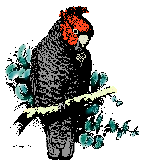This morning Roger Curnow kindly took the time and effort to guide me to
a group of 3 Hooded Robins near the NSW border, adjacent to Dunlop. It
is GrN11 which contains many records in the COG Atlas data base, so I
assume that it is a reasonably well-known area. Roger indicated various
places he had seen the birds in the past, including where he had seen
two adults with one very young dy last year, so we had a good overview
of what is likely to be their territory.
I was particularly interested in the habitat. There were some small
thickets of blackberry and some 'rose hip' bushes- not sure what the
real name is for these bushes. There was virtually no shrub layer but
there were some areas of very stunted elderly trees which were virtually
shrubs. But again, not many of those. There was a lot of fallen timber
and the birds were perching on the fallen timber and dropping down to
the ground to feed. There were areas of longer grass (last season's dead
grass stems) and very short grass. The Hooded Robins were feeding in the
short grass area. (There was a brisk, cold, southerly blowing and the
birds mostly perched head towards the wind). Parts of the territory has
extensive areas of rock, probably some sort of granite, but I am not a
geologist. A couple of Diamond Firetail Finches appeared to be
associating with the Hooded Robins. There were no Noisy Miners. The
territory was virtually surrounded by open paddocks, so I am not sure
about dispersal and recruitment.
Some of you will be aware of a Greening Australia study of birds living
in revegetated areas. As I recall, Hooded Robins did not figure
significantly, if at all. Hooded Robins are one of a suite of woodland
species that can broadly be defined as in some sort of trouble, so the
impact of revegetation on their numbers is a significant issue. Again,
if I recall correctly, the birds found in revegetated areas were mostly
the more common woodland and open grassland species. This leads to the
question: 'How can these plantings be improved to target the rarer
woodland species that are in trouble?'
The promising thing about the Dunlop site is that most of the trees in
the territory appear to have been planted. A lot of the planted trees
have died and fallen over, or have shed branches, providing the fallen
timber. This would mean that it is possible to replace Hooded Robin
habitat that has been previously been destroyed by clearing. If so, the
site would also be worth a closer study in terms of designing plantings
for revegetation.
I am aware that this is a fairly speculative view based on a sample of
one group of Hooded Robins, and I would welcome comments, observations
and critiques.
Con
*******************************************************************************************************
This is the email announcement and discussion list of the Canberra
Ornithologists Group.
List-Post: <>
List-Help: <>
List-Unsubscribe: <>
List-Subscribe: <>
List archive: <http://bioacoustics.cse.unsw.edu.au/archives/html/canberrabirds>
List manager: David McDonald, email
<>
|

